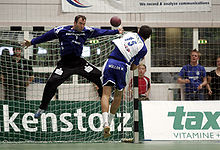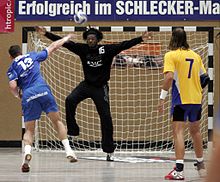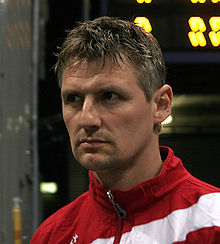Handball goalkeeper

The handball goalkeeper (also known as goalkeeper , goalkeeper , goal player and especially in Switzerland goalie ) is the most defensive player on a team in handball . Its main task is to prevent the ball from getting into its own team's goal.
equipment
A handball goalkeeper must wear a shirt with a number (on the front and back), the color of which is different from that of the field players of his own team and the opposing team (including their goalkeepers). If this is not guaranteed, he must, for example, put on a partially transparent training bib for better differentiation. Most goalkeepers also wear long training pants and male goalkeepers almost without exception wear a groin guard (jockstrap). The wearing of sports shoes is required according to rule 4: 9. In contrast to soccer goalkeepers, goalkeepers do not wear goalkeeper gloves in handball . This has also been prohibited since 2016 according to rule 4.9 of the IHF . Face masks were discussed several times in the past, but are prohibited (according to rule 4: 9), as are head protection, visible piercing, necklaces, earrings, glasses without straps and similar items that may endanger the opponent.
Rules for the goalkeeper
A team must name a player on the court as goalkeeper throughout the course of the game. However, he can take the position of field player at any time after a substitution or shirt change. Likewise, a field player can take the position of goalkeeper at any time. Rule 5 The goalkeeper deals exclusively with the rules that apply to the goalkeeper. A number of special rules apply to goalkeepers, especially within their own goal area. For the purpose of defending the ball, the goalkeeper may touch the ball with all parts of his body in the goal area. The three-second rule (Rule 7: 2), the three-step rule (Rule 7: 3), the rule for tapping the ball (“twice”) (Rule 7: 4) and the multiple ball contact without ground contact of the ball (rule 7: 7). However, if he deliberately delays the passage of the ball, the referees can decide on passive play .
The goalkeeper can leave the goal area without the ball at any time and play on the playing field. Then the same rules apply to him as to every field player. He may leave the goal area with the ball that has not been brought under control and continue playing it in the field of play (Rule 5: 4).
However, he may not leave the goal area with the ball under control after a goalkeeper-throw has been kicked off (Rule 5: 6). If he is in the goal area, he may not touch a ball lying or rolling on the ground outside the goal area (Rule 5: 7) or bring it in (Rule 5: 8). He is also not allowed to go back with the ball from the field of play into the goal area (Rule 5: 9). He must not touch a ball that is already moving towards the field of play or lying in the goal area with his lower leg or foot (Rule 5:10). If the opposing team is seven meters , he must not cross the goalkeeper's boundary line (4-meter line) or its imaginary extension on either side before the ball has left the thrower's hand (Rule 5:11).
If the goalkeeper touches the ball last before he crosses the baseline without scoring, the goalkeeper is awarded the ball to be released from his own goal area. However, if the ball crosses the touchline, the attacking team receives a throw-in.
The goalkeeper is occasionally used as the 7th field player or replaced by a field player. Usually this happens shortly before the end of a game, when the attacking team is just behind after goals. This is to increase the chances of a win or a draw.
Tasks and requirements for a handball goalkeeper
The primary task of the handball goalkeeper is to prevent the ball from crossing the goal line in full diameter by the opposing team, that is, the opposing team from scoring a goal. If the ball is held or discarded, the goalkeeper in modern speed handball has to get the ball back into play as quickly as possible. This means that your own team can score goals through counter-attacks or the so-called "second wave". Due to the fast center , opposing hits, initiated by a fast pass by the goalkeeper, can also be countered. Occasionally, goalkeepers also score goals themselves, for example by throwing the ball across the field into the goal of the opposing goalkeeper if the latter is too far in front of his own goal. The goalkeeper Johannes Bitter was able to score two goals in his 112 international matches.
Body length is a criterion for a goalkeeper, especially in the professional field. A basic rule is "the longer the better" (the late Bundesliga keeper Dieter Bartke was 2.16 m long), but physical disadvantages can often be more than compensated for by other properties such as jumping power and mobility. For example, Wieland Schmidt is 1.85 m and Henning Fritz 1.88 m. Quick reflexes , a quick grasp and the ability to anticipate are more important . Goalkeepers must be able to anticipate game situations, this is made easier by a repertoire of standard situations that they have acquired over the years. In sports science, these standard situations are also called action patterns. Basic requirements are a certain fearlessness of the thrown ball and the collision with the attacker as well as strong nerves in stressful situations.
Typical injuries
Problems in the elbow area are extremely common with handball goalkeepers. In a 1992 study in Norway , 329 of 729 handball goalkeepers (45%) reported pain in the elbow area, while only 166 of 4120 field players (4.0%) complained of such complaints. In a second survey of the 729 goalkeepers (41%) reported acute problems in the elbow area and another 34% reported previous problems. The complaints were recurring pain and injury-related absences of varying duration. These injuries are obviously caused by repeated extreme overstretching of the elbow joint. The authors describe the syndrome as handball goalie's elbow ("handball goalkeeper's elbow"). The correct German name for this injury is elliptical capsular ligament lesion. The hyperextension trauma of the elbow also occurs with lever and hold techniques in judo .
The cause of the pain may be damage to the elbow nerve ulnar nerve . The clarification of the question is the subject of current research in order to develop suitable preventions and treatment options.
Remarks
If a handball goalkeeper receives a time penalty , he has to “serve” it like any other player. As a rule, he is then replaced by another goalkeeper from the team and the team concerned plays with one field player less.
For several years it has been discussed that the goalkeeper should be forbidden to leave the throwing circle in case of counter-attacks. In the past this has resulted in some serious sports accidents.
For teams with a similar level of performance, goalkeeping performance can very quickly become a decisive factor in the game. With a quota of 25 percent or more balls held, one can generally speak of a very good goalkeeping performance. Odds of over 50 percent over more than 30 minutes of playing time are very rare in the active area.
A typical movement to ward off a ball is the so-called jumping jack .
If a player throws unhindered at the head of a goalkeeper who is not in motion, for example with a seven meter throw, the thrower is disqualified (rule 8: 5).
Well-known handball goalkeepers

- Mattias Andersson (multiple German champion, European champion 2000 with Sweden)
- Johannes Bitter (EHF Cup Winner, World Champion 2007, German Champion 2011)
- Henning Fritz ( world champion 2007 , world handball player 2004)
- Martin Galia (Best goalkeeper in the Bundesliga in the 2005/06 season with 508 saves, EHF Cup final 2006)
- Peter Gentzel (213 international matches for Sweden, three times European champion, world champion)
- Stefan Hecker (multiple German champion and cup winner, handball player of the year 1990)
- Silvio Heinevetter (2004 Junior European Champion, EHF Cup Winner 2007)
- Manfred Hofmann ( handball player of the year 1979, world champion 1978)
- Jan Holpert (record player 1st Bundesliga - most appearances)
- Kasper Hvidt (European Champion 2008, bronze EM 2002, 2004, 2006 and WM 2007)
- Michael Krieter (German handball champion with THW Kiel 1994–96, 1998; German and EHF cup winner 1998)
- Niklas Landin Jacobsen (European Champion 2012, World Champion 2019)
- Andrei Lavrov (three times Olympic champion, world champion and European champion)
- Cecilie Leganger (world champion 1999, world handball player 2001)
- Thierry Omeyer (multiple French and German champion, four times world champion, twice European champion, Olympic champion, world handball player )
- Christian Ramota ( European Champion 2004 )
- Sigi Roch (silver medal Olympic Games 1984, once European Cup winner, twice German champion, three times German cup winner)
- Wieland Schmidt (Olympic champion 1980 with the GDR)
- Arpad Šterbik (world handball player 2005, several times Hungarian and Spanish champion)
- Sławomir Szmal (Polish national goalkeeper, current goalkeeper of KS Vive Targi Kielce SA)
- Andreas Thiel (nickname: The Witcher, seven times handball player of the year, five times German champion)
- Andreas Wolff (European Champion 2016 with Germany)
Individual evidence
- ↑ a b c rule 4
- ↑ a b c rule 5
- ↑ Rule 7
- ↑ Johannes Bitter. ( Memento of March 30, 2010 in the Internet Archive ). Retrieved November 27, 2009.
- ↑ Goalkeeper action pattern. ( Memento from April 11, 2013 in the Internet Archive ). Retrieved September 9, 2011.
- ↑ S. Tyrdal, R. Bahr: High prevalence of elbow problems among goalkeepers in European team handball - 'handball goalie's elbow'. In: Scand J Med Sci Sports. 6/1996, pp. 297-302. PMID 8960652
- ↑ S. Tyrdal, AM Finnanger: Osseous manifestations of 'handball goalie's elbow'. In: Scand J Med Sci Sports. 9/1999, pp. 92-97. PMID 10220843
- ↑ S. Tyrdal, OJ Pettersen: The effect of strength training on 'handball goalie's elbow' - a prospective uncontrolled clinical trial. In: Scand J Med Sci Sports. 8/1998, pp. 33-41. PMID 9502308
- ^ MA Ferrara et al .: Modifications of the elbow induced by the practice of handball on radiography, US and MRI. In: JBR-BTR. 82/1999, pp. 222-227. PMID 10589171
- ^ Therapy lexicon of sports medicine. Springer, Berlin / Heidelberg 2006, ISBN 3-540-33522-6 , pp. 73-84.
- ↑ HG Pieper, M. Muschola: Sports injuries and overuse injuries in handball. In: Sports Orthopedics - Sports Traumatology. 23/2007, pp. 4-10.
- ^ TO Kromer: The elbow joint: Basics, diagnostics, physiotherapeutic treatment. Springer, 2004, pp. 96-99., ISBN 3-540-44021-6 .
- ↑ IR Rise ao: Is the ulnar nerve damaged in 'handball goalie's elbow'? In: Scand J Med Sci Sports. 11/2001, pp. 247-250. PMID 11476431
- ↑ U. Akgun et al .: Direction of the load on the elbow of the ball blocking handball goalie. In: Knee Surg Sports Traumatol Arthrosc. September 26, 2007, PMID 17899010
- ↑ J. Bierschwale: accident shocks Handball League: Jakobsen calls consequences. In: The world. December 3, 2001.
- ↑ Rule 8
literature
- A. Thiel ua: Hold like we do. Philippka-Sportverlag , 1999, ISBN 3-89417-079-4 .
- D. Late among others: handball manual. Philippka-Sportverlag, 1997, ISBN 3-89417-063-8 .
- J. Schorer: Top performance in handball goals. Dissertation . Ruprecht-Karls-University, Heidelberg 2006.
Web links
- Tom de Meller: cries of triumph and pain. In: Friday. February 9, 2001.
- Torhueter.ch





